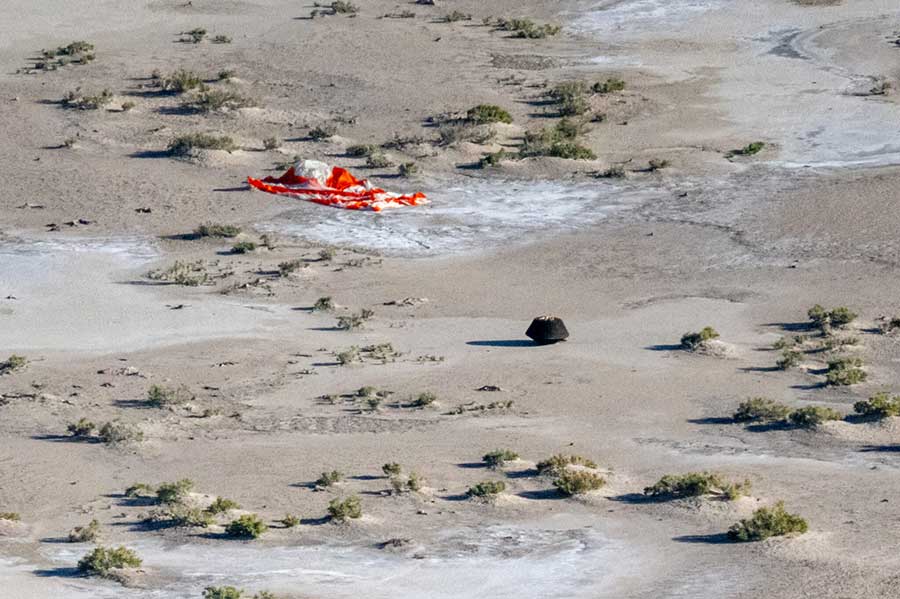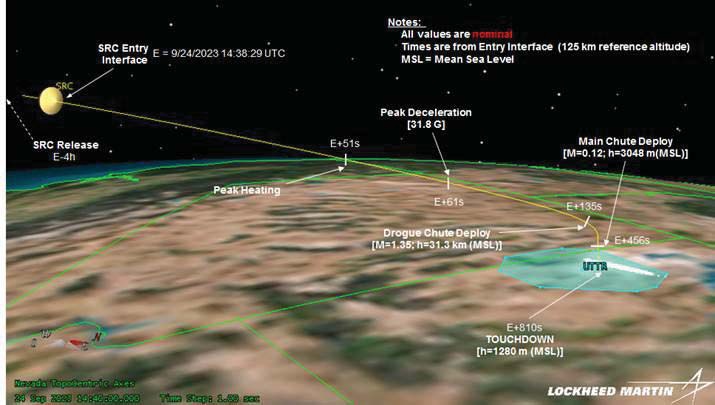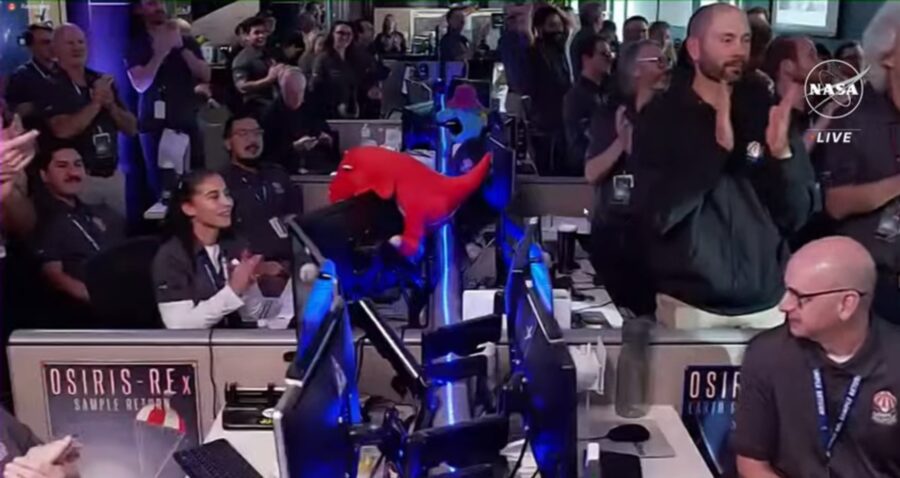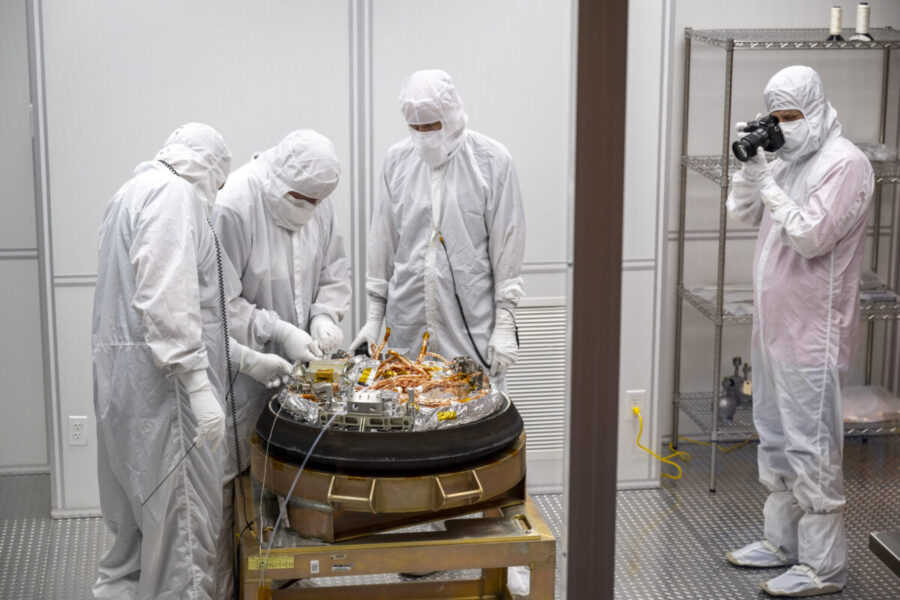Samples taken from the asteroid Bennu are now safely on Earth.

NASA / Keegan Barber
It’s been a long time coming, but after a journey of seven years and 4.4 billion-miles (7.1 billion kilometers), NASA’s Origins, Spectral Interpretation, Resource Identification, Security-Regolith Explorer (Osiris-REX) spacecraft has accomplished its primary mission: It has returned its sample capsule to Earth, containing material grabbed from asteroid 101955 Bennu.

Lockheed Martin
The return happened over the U.S. Department of Defense's Utah Test and Training Range. The 101-pound (46-kilogram), table-size capsule separated from the spacecraft four hours prior to touchdown on Sunday, September 24th, while it was still 63,000 miles (about a quarter of the Earth Moon distance) away. The capsule came in hot this morning over the California Pacific coast and by 10:52 a.m. EDT / 14:52 UT, the capsule was on the ground. The Osiris-REX mission dispatched helicopter search teams to search the 58-by-14 kilometer reentry area, and the team retrieved the sample shortly afterward.

NASA TV
The capsule is similar to the one used by the Stardust mission, which returned material from Comet 81P Wild 2 in 2006. Onboard Osiris-REX's capsule is just over a quarter of a kilogram of material collected from asteroid Bennu in 2020.
The accomplishment represents NASA’s first collection of a pristine asteroid sample, that was brought to Earth for study.
"The first estimate [of sample weight] will be no earlier than September 27th for internal planning purposes," says Jason Dworkin (NASA-GSFC). "But this is not the official mass since this is a weight while still inside of the Osiris-REX TAGSAM head. The exact mass will be announced on October 11, 2023."
Expect to see a first look of random material, expected to be loose inside the canister, no earlier than September 27th.

The mission had a long path from launch pad to Bennu, and then back to home. Launched atop an Atlas 5 rocket from Cape Canaveral Air Force Station on September 8, 2016, Osiris-REX took more than two years and one Earth flyby to just reach Bennu.
Osiris-REX first caught sight of Bennu in August 2018 and entered a station-keeping path in step with the asteroid in late 2018. Like Hayabusa 2’s target, 162173 Ryugu, Bennu turned out to be a diamond-shape, rubble-pile world.
As Osiris-REX mapped Bennu, four potential sample sites were selected, then narrowed down to one primary region, known as Nightingale. The big day and the climax of the mission occurred on October 20, 2020, when Osiris-REX reached out to "touch" Bennu, firing a burst of gas from the TAGSAM sample head.

In the end, TAGSAM worked almost too well, as images of the sample head after sample acquisition showed overflowing material creeping out from past the closure flap. Engineers made the quick decision to immediately stow the sample head to prevent further loss, bypassing a spacecraft rotation maneuver to weigh the samples collected.
"There are 12 hypotheses and 54 sub-hypotheses the science team will be testing," says Dworkin. "They fall in four categories: 1). evaluate the interpretation of data collected at Bennu from the camera and spectrometers; 2). look at organic compounds of interest for the formation of life and chemical pathways that led to their formation and destruction in Bennu; 3). Use Bennu sample to investigate the history of the solar system from the formation of the proto-solar nebula all the way to the formation of the Hokioi crater from where the sample was collected; and 4). How has the sample changed since it was collected (physically and chemically)."
Sample returns from the past include NASA’s Stardust and Genesis missions, and JAXA’s Hayabusa 1 and 2. Return and Earth atmospheric entry are crucial phases for any mission; for example, the parachutes for the Genesis capsule over Utah failed to properly deploy during the 2004 return, leaving the capsule to plummet and crash to the ground.

What’s Next for the Samples
Now, the samples will make their way to the Astro Materials Research & Exploration Science (ARES) curation facility at NASA’s Johnson Spaceflight Center for study, evaluation, and eventual sharing with international partners.
"Osiris-REX has close partnerships with the Japanese Space Agency (JAXA) and the Canadian Space Agency (CSA)", says Olivier Barnouin (Johns Hopkins Applied Physics Laboratory ). "Both Japan and Canada are slated to get samples. Additional scientists from around the world will also be given access to samples."
Specifically, JAXA and CSA will receive 0.5% and 4% of samples, plus one contact pad each, respectively.
The samples represent pristine material from the primordial solar system. Plus, studying a rubble-pile asteroid like Bennu could prove useful should we ever have to move one out of the way. Bennu itself has a 1-in-2,700 chance of an Earth impact, mid-next century on (mark your calendars) exactly 159 years from today on September 24th, 2182.
With the capsule now safely on the ground, the mothership itself has an encore mission. It's now headed towards its next target: the near-Earth asteroid 99942 Apophis. That mission will have a new name: Osiris-APEX. It should reach the asteroid in April 2029, just after the asteroid swings by Earth in a close approach.
The sample return for Osiris-REX is a milestone for NASA as we attempt to unlock the secrets of the early solar system.
 0
0









Comments
You must be logged in to post a comment.